Physics For Kids
The best way to teach physics for kids is also the best way to teach physics for adults. You present them with a real-world set of objects they are interested in and which demonstrate the different principles of physics. And joyful learning automatically follows from this.
For kids, the objects which are naturally the most interesting to them are toys. Kids love toys! They can spend hours engaged in creative play time and exploration with them. As they become immersed in the toy they start to get a feel for how it works, and learn all the tricks to get the maximum entertainment out of it. And if the toy demonstrates a principle (or two) of physics then it will be these principles that they get a feel for. The abstraction of the physics is not important for the early stages of development which kids undergo. But what is important is to get exposure to it, and it is this exposure which can plant that all important seed for future curiosity and academic pursuit in the sciences.
Physics is perhaps the broadest and richest of all the sciences. And in terms of everyday phenomenon, it is among the most relevant to people's lives. For example, the physics of sports is a very popular subject on this website. Many people play sports and it is natural for some of them to seek out the physics of the particular sport they are interested in. People who are not otherwise interested in physics will be interested in the physics behind the sport they are playing.
Toys often involve a lot of physics just by how they work. For example, when a child sees a toy car race around a vertical loop without falling, he or she might wonder why it doesn't fall when it reaches the top. The reason is because of the effects of centripetal acceleration, which is a well-known physics concept. With repeated play the child will soon discover that there is a minimum speed that the car needs to have to avoid falling off the loop. By doing this he or she will have developed a feel for the physics even though they don't understand the mathematics behind it. They don't need to at this stage. The important thing is to observe the physics in action and with practice figure out how to get the toy to work the way they want, which unavoidably is going to involve the application of physics (whether they realize it or not).
Therefore, teaching kids physics, by way of toys, is a very practical approach and will give them a head start in physics. And it will do this in a way which is already very interesting to them anyway, through play time with toys. This will be a great addition to the learning they are already doing in their science classes.
In the sections below I introduce several key areas of physics and then list the toys which readily demonstrate those areas of physics. These toys have been handpicked by me out of a great many toys that are available to buy. I have saved you a lot of investigative work by picking out those toys which best demonstrate a specific physical process, or processes, at work. I made an effort to list these toys under the physics categories I thought were most applicable, but keep in mind that some toys utilize physics principles which cover different categories.
It is my firm belief that you will find these toys to be of great value, whether you're a parent, or a teacher who wants to give fun and informative science demonstrations.
Electricity
Electricity is the flow or movement of electrically charged particles. It is a form of energy. The outlets in your home are a source of electricity and you plug appliances into them in order to make them run. The great usefulness of electricity is due to its ability to be carried over long distances. In addition to the outlets in your home, another source of electricity is batteries, which you use to power things such as radios and flashlights.
Learn more about electricity with the following toys.
 Dynamo Torch
Dynamo Torch
A light that is turned on by a hand cranked generator. The faster you crank it, the more it lights up.
 Fly Stick
Fly Stick
A "magic" stick which levitates objects using static electricity.
 Plasma Ball
Plasma Ball
Creates colorful filaments of electricity inside a glass sphere.
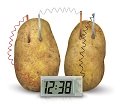 Potato Clock
Potato Clock
A clock which runs using electricity generated with potatoes.
 UFO Ball
UFO Ball
A ball that emits colorful lights and makes eerie alien sounds when the circuit is closed using your body.
Energy
Energy is the ability to do work. It is what enables something to "do something". For example, gasoline in a car is a source of energy which enables the car to move. The sun is a source of energy which heats the earth and sustains all processes that make the planet suitable for life such as ours.
Energy can also change from one form to another. For example, I can rub two sticks together to make them warmer. What I am doing is changing the energy of motion (due to the rubbing action) into heat energy, which is what makes the sticks warm up.
Learn more about energy with the following toys.
 Drinking Bird
Drinking Bird
A plastic bird which dips forward and back due to the action of an expanding liquid.
 Hand Boiler
Hand Boiler
Demonstrates a liquid that boils using only the heat of your hand.
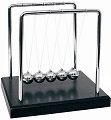 Newton's Cradle
Newton's Cradle
Consists of a frame and colliding metal balls that demonstrate momentum and energy transfer.
 Salt Water Fuel Cell Car
Salt Water Fuel Cell Car
You place a drop of salt water in this toy car and it runs.
Force And Motion
When you push or pull on an object you are exerting a force on it. If the object is not held in place by something then it will move. The harder you push, or pull, on the object the faster it will move. Forces are fundamental to nature and arise from the contact between two or more objects. Objects that are in contact exert a force on each other and objects that are not in contact do not exert a force on each other. An exception to this is gravity and magnetism which both cause a force to be exerted between objects even if they are not touching. Gravity and magnetism can be thought of as "invisible" forces.
There are also aerodynamic forces which (for example) are the forces which hold up a plane and move it forward. These forces are caused by the contact of the plane body, and propeller, with the surrounding air.
Learn more about force and motion with the following toys.
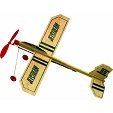 Balsa Glider
Balsa Glider
A very lightweight toy plane made of balsa wood. Fun to throw around and watch it fly.
 Boomerang
Boomerang
An object that returns to you after it's thrown.
 Chaos Tower
Chaos Tower
A tower that you create in which a falling ball travels down though various physical obstacles, of your design, before reaching the bottom.
 Euler's Disk
Euler's Disk
A spinning disk which gains speed the more it falls.
 Galileo Thermometer
Galileo Thermometer
Gives you the temperature of the room using bulbs suspended in a liquid inside a tube, which move up or down depending on the room temperature.
 Gyro Ring
Gyro Ring
A big ring with small washers inserted into it. These washers can be made to spin around continuously, just by turning the ring a certain way.
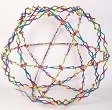 Hoberman Sphere
Hoberman Sphere
A large sphere that folds down to a much smaller compact size.
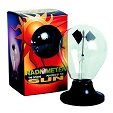 Radiometer
Radiometer
Uses the light of the sun to spin vanes.
 Rattleback
Rattleback
You give this a spin, it slows down and then spins in the other direction.
 Slinky
Slinky
This is one of those toys that everyone has heard of! It's a flexible spring which can go down a flight of stairs, or appear to levitate.
 Solar Bag
Solar Bag
An air filled bag heated up by the sun, which floats in air.
 Spinning Top
Spinning Top
You give it a spin and it keeps going and going, without falling over, appearing to defy gravity.
 Stomp Rocket
Stomp Rocket
Step on an air filled bladder and the resulting air pressure shoots a rocket up at high speed.
 Tim Bird
Tim Bird
A flapping mechanical bird that uses a wound up rubber band to power its flight.
 Tippe Top
Tippe Top
A spinning top that, when spun, flips upside down and continues spinning.
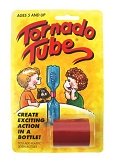 Tornado Tube
Tornado Tube
Creates a vortex inside a bottle, using water. It looks like a tornado.
 Toy Gyroscope
Toy Gyroscope
A wheel which rotates on a pivoted base without falling down due to gravity.
 Toy Hovercraft
Toy Hovercraft
A vehicle that can float and move around on a cushion of air.
 Water Rocket
Water Rocket
Uses compressed air and water to launch a bottle rocket straight up.
Gravity
Gravity is a type of force related to the mass of objects. It is fundamental in nature. It is a force of attraction which exists between all objects. The more mass an object has, the greater its gravitational force of attraction on other objects. All objects have mass which means that all objects exert a gravitational "pulling" force on all other objects, but unless an object is very massive (like the earth) the amount of gravitational force it exerts on another object is negligible. Everyday objects such as cars, bicycles, and buildings are way too small to exert significant gravitational force.
The other interesting thing about gravity is that the gravitational "pulling" force between objects occurs no matter how far away they are from each other. But the closer two objects are the more gravitational force exists between them. For example, a gravitational force exists between you and the (very massive) earth which means that you are "pulled" towards the earth. This pulling force is what keeps you on the ground. Otherwise you would float away. If you lift an object, such as a ball, and let it go, it will fall. This is due to the force of gravity pulling down on it.
An object is said to defy gravity if it floats above the ground and doesn't fall. For an object to do this it must generate a lifting force to resist the force of gravity so that it doesn't fall.
Learn more about gravity with the following toy.
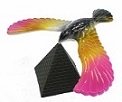 Balancing Bird
Balancing Bird
A plastic bird that is balanced by its beak.
Light
Light is a form of electromagnetic radiation that is visible to the human eye. It is what allows us to see something. The sun is a source of light and so are the light bulbs in your house when they are turned on. A source of light will illuminate objects that it is shined upon, and that light is then reflected from those objects and towards our eyes, which is what we see. Light is made up of different colors which is what allows us to see objects in different colors. When light shines on an object, the different colors of the object that we see (such as red, yellow, and green) is due to some colors of light being absorbed by the object and other colors of light being reflected by the object. The light that is reflected is what we see, and the color of the reflected light is the perceived color of the object. The color of the light that an object reflects depends on the surface properties of the object. For example, some objects appear red and others appear green, depending on the surface properties of the object. The large variety of color that we see in the world is due to the large variety of color combinations that reaches our eyes from reflected light.
If all light is reflected from an object we see it as white. If no light is reflected from an object we see it as black. The color white is all the colors combined, and the color black is actually the absence of color (since no light is reflected and hence does not reach our eyes).
Learn more about light with the following toys.
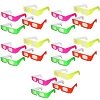 Diffraction Glasses
Diffraction Glasses
Allow you to see the color spectrum from different light sources. It can really enhance a fireworks experience.
 Kaleidoscope
Kaleidoscope
This is one of the oldest science toys. It creates a beautiful and mesmerizing display of images created by the reflection of light, using multiple mirrors.
 Mirascope
Mirascope
Creates an image that looks completely real, but is not.
 Prism
Prism
Separates white light into its component colors, similar to a rainbow.
 Toy Microscope
Toy Microscope
Magnifies very small objects so you can see them clearly.
 Toy Telescope
Toy Telescope
Allows you to see far away objects that you can't normally see.
Magnetism
Magnetism is an invisible force of nature, like gravity. It is caused by the magnetic properties of certain materials. A magnet can, like gravity, attract another object toward itself, but it can also repel an object away from itself, provided that the other object is also a magnet oriented a certain way relative to the first magnet (this is demonstrated with the toy shown below).
With magnetism only one object needs to be magnetized to attract another object, provided that the other object is a ferrous metal such as iron. Two magnets will also attract each other. However, a non-ferrous metal such as aluminum cannot be attracted to a magnet due to its atomic structure.
Only metals can be turned into magnets, and it is only those metals which are attracted to magnets which can themselves be turned into magnets, such as iron.
Metals can be turned into magnets by wrapping loops of wire around them and then running an electric current through the wire. But exactly how this works is something that is taught in advanced physics courses.
Some magnets exist naturally such as lodestone.
Learn more about magnetism with the following toy.
 Levitron
Levitron
A device in which a spinning top floats above a magnet. It looks like an anti-gravity machine!
Sound
Sound is a vibration, or a disturbance, that travels through a medium such as air or water. We are most familiar with sound that travels through air, which is sound that we hear. But animals that live underwater, such as whales, can hear sound that travels underwater.
If there was no air we would hear no sound, since the lack of air means that sound vibrations cannot travel to our ears. Sound that we hear originates from an object which vibrates and which disturbs the surrounding air, sending sound waves through the air and to our ears. It's the same principle as putting your finger into a pool of water. The point where you touch the water creates a disturbance in the water which sends out waves which you can see. This same idea applies to sound that we hear. Something, such as a plate falling on the floor, will create a disturbance in the air surrounding the plate, and that disturbance travels through the air and to our ears which we hear as a loud crash.
Learn more about sound with the following toy.
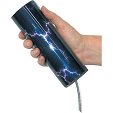 Thunder Tube
Thunder Tube
Creates a realistic thunder sound using a hollow tube closed on one end, and a flexible spring.
The following sections are more theoretical in nature and involve an overview of the subject matter without going into too much detail. The topics presented below are among the most relevant to what parents and teachers are looking for when teaching their kids about the sciences.
Aerodynamics
Circuits
Heat Transfer
Quantum Physics
Thermodynamics
Renewable Energy
Renewable energy is a form of energy which uses natural non-polluting energy sources in the environment which occur naturally and which will not run out over time, unlike fossil fuels. No single renewable energy source can satisfy energy needs everywhere in the world. The reason for this is because different parts of the world have different geographic features which make one renewable energy source more feasible than another. For example, depending on where you live, wind power may be more feasible than solar power, and so forth. This is why renewable energy sources must be "shared" across borders, and by doing this all the world energy needs will be satisfied.
Renewable energy naturally ties into applied physics so it's a good fit for this page. It is a very important topic in today's world and it is important to make it accessible to kids since they will be tomorrow's leaders. Hence I make an effort to make the material as interesting and relevant as possible while aiming it at a level suitable for kids.
Biomass Energy
Geothermal Energy
Hydro Energy
Nuclear Energy
Solar Energy
Tidal Energy
Wave Energy
Wind Energy
Return to Real World Physics Problems home page
Free Newsletter
Subscribe to my free newsletter below. In it I explore physics ideas that seem like science fiction but could become reality in the distant future. I develop these ideas with the help of AI. I will send it out a few times a month.